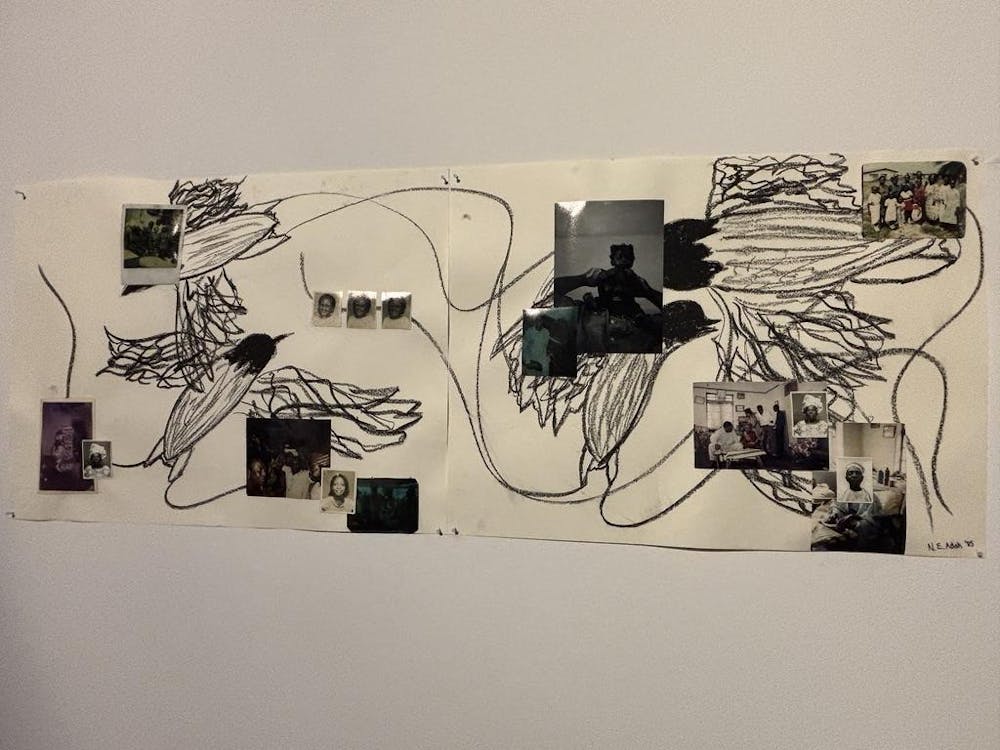The Black Arts Collective’s (BAC) latest exhibition at the CoLab in the Lewis Arts Complex greeted me with projections of light and images and ethereal riffs of music on loop.
“Terms for Existence,” open until Monday, is curated by Ariel Sylvain ’26, Nsebong Efiok Adah ’26, and Star Ross ’27. The exhibition explores writer James Baldwin’s reflections on the African American experience, particularly the tensions and complexities of Black spirituality and divinity. The exhibit’s name was inspired by a quote from Baldwin’s book “The Fire Next Time.” “The universe … has evolved no terms for your existence,” Baldwin writes, pointing to the suppression of Black people in American society.
The exhibition spans several media, including painting, photography, poetry, sound, and video. Through fifteen vastly different student artists’ interpretations of “Terms of Existence,” the exhibition asserts the intricacies of Black cultural history by approaching Black spirituality and identity from multiple perspectives.
The exhibition was thoughtfully curated in a spacious room, with artists’ works illuminated against dimly lit walls. Each piece was also given adequate space, and the layout was not crowded.

The “Terms for Existence” exhibit at the Lewis Center for the Arts
Amy Jeon / The Daily Princetonian
My favorite work was a mixed media piece by Sylvain, titled “Simply a Sounding Drum (What is Clean).” Inspired by a line in Baldwin’s “Down at Cross: Letter from a Region in my Mind” that reads, “And the universe is simply a sounding drum,” Sylvain plays with integral elements representing the terms of her existence — particularly her ancestry and faith.
In a black and white collage, an intricate architectural drawing connects a photo cutout of young Sylvain in a communion gown sewn by her grandmother to a black field of paint, where a mirror is placed on a depiction of a house. A Bible verse in French is scrawled in cursive, echoed as both an inquiry and affirmation of faith. The photo cut out of Sylvain is placed by a depiction of a drum as a golden halo surrounds her head, emulating sacred figures in medieval religious art.
Sylvain’s artwork is her own form of autoethnographic experiment, allowing her to explore her personal culture and history.
“In this experiment, I am thinking through my terms for existence,” Sylvain said in the work’s description. “This is me beating the drum, and as I rest on the laps of my intellectual predecessors. I do so opaquely. It is messy, it’s clean.”

“Simply a Sounding Drum (What is Clean)” Ariel Sylvain ’26
Amy Jeon / The Daily Princetonian
Several other works of art also caught my attention as I explored the gallery.
In a hauntingly stark poem titled “Restoration,” Torey Bullock ’28 explores the ties between Black suffering and Christianity. On aged paper, Bullock challenges the history of Black oppression, placing faith in God that he will reconcile historic wrongs. Written in four quatrains of free verse, the poem employs short and simple fragments to piece together a powerful message about the strength of faith in the face of adversity.


“Restoration” by Torey Bullock ’28
Amy Jeon / The Daily Princetonian
In a mixed-media painting on canvas, “Is a Higher Power Guidin We,” Kefeshe Bernard GS uses cotton fabric to craft a depiction of Moko Jumbie, a Trinbagonian carnival spirit said to walk alongside trafficked captives in the Middle Passage. The cotton fabric has the words “100% cotton” stamped onto it, linking the figure to the cotton industry and the slave trade. In addition, the colors of the fabric figure are red, black, and light gray, which mirror the flag of Trinidad and Tobago. High-energy Trinidadian soca music also plays, contributing to a sense of festivity.

“Is a Higher Power Guidin We” by Kefeshe Bernard GS
Amy Jeon / The Daily Princetonian
“Terms for Existence” is a thought-provoking exploration of Black culture, identity, faith, and history that balances different artistic approaches with a cohesive, multidimensional viewing experience. The exhibition also considers Baldwin’s prose in “The Fire Next Time” well, tying Baldwin’s testimonial-style narration of his identity and experience in church to the different artists’ narrations of their identities and spirituality.
The exhibition is free and open to the public at the CoLab on the Forum level of the Lewis Arts Complex.
Amy Jeon is a contributing writer for the Prospect and a member of the Class of 2029. She can be reached at aj9410@princeton.edu.
Please send corrections to corrections[at]dailyprincetonian.com.








